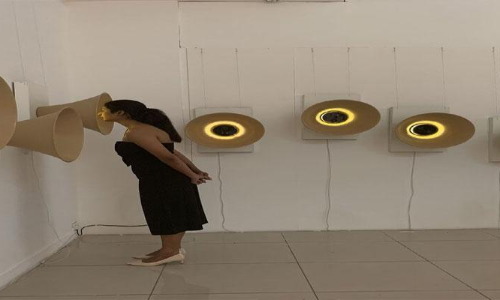Live
- VIP Treatment: Exclusive Benefits for High Rollers in Online Casino
- LS polls: Union Minister Bhagwanth Khuba, Dingaleshwara seer, Priyanka Jarkiholi file nominations in K'taka
- Amid show of strength, Congress’ Praniti Shinde files nomination from Solapur
- Tamil Nadu Police gives clean report to Isha Foundation in missing volunteers case
- Home Minister Amit Shah to address public meeting in Goa on April 24
- Gurgaon Open: M Dharma fires 67 for two-shot lead on penultimate day
- Sharad Pawar made many attempts to finish Shiv Sena, claims Maha minister
- Former England opener Raman Subba Row dies aged 92
- IPL 2024: Impact player rule is affecting the progress of half all-rounders, says Zaheer Khan
- ‘Teppa samudram’ review: Entertains with twists and turns
Just In

The exhibition Sniffing out the Differences with interactive installations maps into scents and visualisations explores the tales and olfactory associations in south Asian cultures from the past, present and future
The exhibition ‘Sniffing out the Differences’ with interactive installations maps into scents and visualisations explores the tales and olfactory associations in south Asian cultures from the past, present and future. Some factual and some fictional! Olfaction is the least explored sense as compared to the other senses when making sense of information in our environments. Can we imagine food without its smell? We often fail to notice how much smells contributes to an experience.
It has been long associated with deep memories and evokes a deep emotional response. Smelling the petrichor, many are reminded of their childhood memories and games. Responses to odours are sometimes so strong that certain scents are liked or disliked because of the emotional associations with them. Smell is not just a biological and psychological experience, but it has both, social and cultural contexts as well. Sniff certain spices, perfume, scents and you will be reminded of a certain culture and region.
There are many aspects of the cultures, which are akin to fragrances, sometimes leaving even the most articulate person speechless. There is an inability in the language to define this experience, which can be understood only by experiencing it. This exhibition, ‘Sniffing out the Differences’, with the help of interactive installations explains the culture with its mapping it into scents and visualisation. It talks about how new identities and cultures emerge with mobility and new distinct patterns that are created, like the patterns in the kaleidoscope which are distinct as an experience in the smell.
Exhibits on display
Jallianwala Bagh:
The Jallianwala Bagh massacre is a spine-chilling reminder of the lows to which humanity can go to suppress the aspirations of others. The brutality of the shooting left 250 million people under the Raj shocked and led them to a profound questioning of their identities, which added fuel to the freedom struggle. This interactive installation explores this narrative and remediates it through smell. It explores the power imbalances at play and how there is a tendency to reduce the ‘other’ and to strip them of their personhood. It also explores the possibility of such events occurring in current times.
Identity stories:
Identity stores is an interactive, biographical installation depicting the life journeys of people and the emergence of their identities through an olfactory exploration of culture with a focus on distinct smells. It looks at the subjectivity of human experience by delving deep into the memories of people to illuminate the shaping of the individual. It builds on smell associations created over the lifetime of the individual. It explores how new identities emerge due to increased mobility and how new distinct perceptions of their individual identities are built over time.
Mir Abdul Attarwala:
Amidst the surrounding beauty and conflict of Kashmir, a young apprentice learning the craft of perfumery tries to contain his feelings in attars (perfumes). The attars, some pleasant, some repulsive, talk about the tales that emerge in any conflict zone.
XENO 500:
Set in an alternate timeline in India, this exhibit paints a scenario of how xenophobia would be treated as a social evil and a critical condition. The belief, in this new India, is that contribution and cooperation by all citizens leads to the maximum development of the urban atmosphere. The mandate is to identify xenophobic individuals and help them recover from this primitive human condition. As a by-product of the prescribed treatment, using the Xeno 500 drug, the individuals tend to have varying body odour.

© 2024 Hyderabad Media House Limited/The Hans India. All rights reserved. Powered by hocalwire.com







